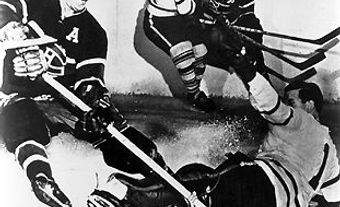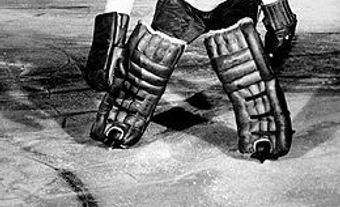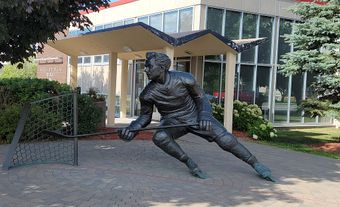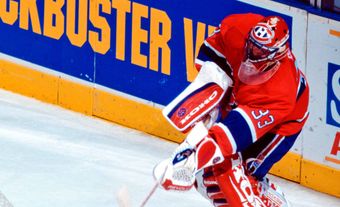The Montreal Canadiens are the oldest professional hockey team in the world and one of the most storied franchises in professional sports. Founded in 1909 and officially called the Club de Hockey Canadien, the team (also known as the Les Habitants, or Habs for short) is the only existing National Hockey League (NHL) franchise to have formed prior to the league’s inception in 1917. One of the NHL’s “Original Six,” it is the only team to have operated continuously throughout the league’s history. The Canadiens have won 24 Stanley Cup championships — more than any other organization — and have appeared in the Stanley Cup Finals 35 times, most recently in 2021. More than 60 Canadiens players and personnel have been inducted into the Hockey Hall of Fame, including such legendary figures as Howie Morenz, Georges Vézina, Maurice “Rocket” Richard, Jacques Plante, Henri Richard, Jean Béliveau, Ken Dryden, Guy Lafleur and Patrick Roy.

|
Quick Facts About the Montreal Canadiens |
|
Founded: 4 December 1909 |
|
Venue: Bell Centre |
|
Team Colours: Red, white and blue |
|
Regular Season Record: 3,473 wins, 2,302 losses, 837 ties, 175 overtime/shootout losses |
|
Playoff Record: 440–321 |
|
All-Time Goals Leader: Maurice “Rocket” Richard (544) |
|
All-Time Points Leader: Guy Lafleur (1,246) |
|
Most Wins by a Goaltender: Carey Price (360) |
|
Most Wins by a Coach: Toe Blake (500) |
|
Most Stanley Cup Victories as a Player: Henri Richard (11) |
|
Most Stanley Cup Victories by a Coach: Toe Blake (8) |
|
Stanley Cup Finals Appearances: 35 |
|
Stanley Cup Finals Victories: 24 |
Early Hockey in Montreal
Regulated senior hockey first arrived in Montreal thanks to students at McGill University, who began playing hockey on Montreal's Victoria Skating Rink in 1875. By 1880, the group had written a set of rules for teams to follow, and in 1886, they helped to organize the Amateur Hockey Association of Canada (AHAC), which included four teams from Montreal and one team from Ottawa; a team from Québec City would join the league in 1892. One Montreal team, the Montreal Hockey Club, won the first Stanley Cup awarded in 1893. At a time when any team in Canada could challenge for the Cup at any time during the season, Montreal teams would continue to dominate the Stanley Cup wins, with the Montreal Hockey Club winning again in 1894 and 1895, and the Montreal Victorias winning in 1895, 1896, 1897 and 1898.
When the AHAC folded in 1898, it was reorganized as the Canadian Amateur Hockey League (CAHL). During its first two years in operation (1899 and 1900), the Montreal Shamrocks were the Stanley Cup champions. The Montreal Hockey Club reclaimed the Stanley Cup with victories in 1902 and 1903. In 1905, the CAHL was replaced by the Eastern Canada Amateur Hockey Association (ECAHA). The Montreal Wanderers proved to be the team to beat, as they won and successfully defended the Cup in 1907 and 1908.
In 1909, the ECAHA dissolved and reformed as the Canadian Hockey Association (CHA). The Montreal Wanderers were excluded from the new league, and as a result, formed their own league, the National Hockey Association (NHA). By February 1910, the CHA had merged into the NHA.

Montreal Canadiens (NHA)
The Montreal Canadiens were founded on 4 December 1909 by John Ambrose O'Brien, who named Jean-Baptise “Jack” Laviolette as the coach and general manager. In one month, Laviolette recruited 15 players for the team, and they played their first game as a member of the Canadian Hockey Association on 4 January 1910. Days later, the Canadiens joined the newly formed National Hockey Association. They finished their first season in last place. Prior to the start of their second season, Le Club athlétique canadien, a Montreal sporting organization from whom O'Brien's Canadiens borrowed their name, became a National Hockey Association franchise. O'Brien's Canadiens ceased operations, while Le Club athlétique canadien kept the Montreal Canadiens name.
The next two seasons were disappointing, as the Montreal Canadiens finished in last place in the league. By the 1915–16 season, however, the team was in top form, earning their first playoff berth and a chance at the Stanley Cup. Led by Newsy Lalonde, Jack Laviolette and goalie Georges Vézina, the team won the Stanley Cup for the first time, defeating the Portland Rosebuds of the Pacific Coast Hockey Association in the 1916 Stanley Cup Final.

Logo and Nickname
In 1917, the Canadiens took to the ice in new uniforms with a new crest — a stylized C with an H in the middle. The letters in the crest symbolized the team’s new official name, the Club de Hockey Canadien. The H in the logo stands for hockey, not habitant, as many believe. This misconception apparently originated with Madison Square Garden owner Tex Rickard, who mistakenly told a reporter in 1924 that the H stood for habitant. The word — the name for land-owning settlers of New France — was by then a common nickname for the team. The first known reference to the Canadiens as the “Habitants” was in Le Devoir on 9 February 1914, in the description of a game against a team from Toronto. (“Sans contredit les ‘Habitants’ eurent l’avantage continuellement.”/ “Without a doubt, the ‘Habitants’ constantly had the edge.”) The term’s association with the club is believed to stem from the fact that the team was marketed as the city’s French hockey club, as opposed to the English team, the Montreal Wanderers. In those early years, many Canadiens fans would even show their affiliation with the club by attending games in traditional habitant attire such as tuques, moccasins and brightly colored sashes.
More recently, however, the term habitant has fallen out of favour with French Canadians, who see it as a derogatory word generally meaning “uncouth peasant.” As Mark Abley has explained, “In contemporary French, if you have ‘habitant manners’ you’re a country bumpkin. If you want to disparage the traditional folksongs of the province, call them ‘habitant music.’ As they turned their backs on the Roman Catholic church and the agricultural past, Quebecers rejected many of the symbols they had once held dear — habitants among them.” (See Habitants and French-Speaking Quebec.) Abley has also explained that the shortened version of the term, habs, “does not suffer from the negative associations of ‘habitants.’”
Other popular nicknames for the team have emerged over the years, including le Grand Club, le CH (short for Club de hockey), les Glorieux, le Bleu Blanc Rouge and la Sainte-Flanelle (the “holy flannel” or “holy sweater”).
Montreal Canadiens (NHL)
The team began the 1917–18 season as a founding team of the National Hockey League (NHL). The Canadiens lost the NHL's first championship in 1918 to the Toronto Arenas, who would become the first NHL team to win the Stanley Cup. During the 1919 Stanley Cup playoffs, the Canadiens won the league championship over the Senators but were not successful in their run for the Stanley Cup that year. Both the Canadiens and their rivals, the Seattle Metropolitans of the Pacific Coast Hockey Association, lost many players to the influenza pandemic, and the series was interrupted; consequently, no winner was declared, and the Stanley Cup was not awarded in 1919.
The team established its reputation for flair, speed and offensive power early in its NHL history; in addition to Joe Malone and Aurèle Joliat, it had, in Howie Morenz, the most exciting player of the 1920s and 1930s. Though the Canadiens missed the playoffs from 1920 to 1922, they returned to post-season play after a successful 1922–23 season. Those playoffs, however, were marked with controversy, as captain Sprague Cleghorn was suspended by his own team for a vicious check against Ottawa Senators player Lionel Hitchman. Ottawa won the league championship, as well as the Stanley Cup. By the next playoffs, Montreal proved to be in top form — and on better behaviour. In the spring of 1924, the Canadiens won their first Stanley Cup as an NHL team.
The Canadiens would, once again, be named league champions in 1925, though not as a result of their play. Hamilton, the top team in the league, was suspended after its players demanded they be paid for playing in the post-season —the first strike in NHL history. The Canadiens would not be successful in the Stanley Cup finals, losing to the Victoria Cougars, who became the last team outside the NHL to win the Cup. The Canadiens finished the next season in last place, following a 12-game losing streak.
In 1926–27, the NHL expanded to include 10 teams, as three teams from the failed Western Hockey League joined the NHL. The Canadiens finished second in the Canadian Division but, once again, lost the Stanley Cup semi-final, this time to the Ottawa Senators. The team thus began the 1927–28 season determined to finish on top of the league. The season was a triumph, including a 19-game win streak. However, an overtime goal by the opposing Montreal Maroons sealed the Canadiens' fate in the playoffs, and the team missed the Stanley Cup finals.
The 1928–29 season is considered one of the most successful in team history. Over the course of the season, the team lost just seven games, won 22 games by shutout, and ended the season with an eight-game win streak. Success did not spill over to the playoffs, however; the Canadiens lost a spot in the Stanley Cup finals to the Boston Bruins.
1930s
The Canadiens began the 1930s on a high note, finishing as Stanley Cup champions in both 1930 and 1931, the first back-to-back Stanley Cups for the team. The team claimed its fourth Canadian Division title in five seasons in 1931–32 but lost in the semifinals to the New York Rangers. The loss marked the beginning of a downward trend for the team, which spent the first half of the next season in last place in the Canadian Division, and finished the season tied for third. In the post-season, the team was knocked out in the quarterfinals, again at the hands of the New York Rangers. The playoffs would end just as quickly during the 1933–34 playoffs, this time against the Chicago Blackhawks.
Canadiens' general manager Léo Dandurand made 15 trades over the next season. Although the first half of the season was sprinkled with team losses, by the second half, the team managed to win enough points to finish third in the Canadian Division. Their post-season would, nonetheless, be cut short once again by the Rangers. Following the loss, the Canadiens were sold to the Canadian Arena Company. The new owners traded players in an effort to bolster the team but with little success; the Canadiens finished the 1935–36 season in last place, and, for the first time in a decade, missed the playoffs.
Former Canadiens star Howie Morenz returned to Montreal for the 1936–37 season; however, his tenure was short lived. On 28 January 1937, Morenz broke his leg during a game and died on 8 March from complications. With Morenz suddenly gone, the Canadiens' spirits were low; the team was easily knocked out of the Stanley Cup semifinals by the Detroit Red Wings, and the following season they lost to the Chicago Blackhawks in the quarter-finals. Montreal met Detroit again during the playoffs of the 1938–39 season, with the same result.
1940s
By the start of the new decade, the Montreal Canadiens and their fans were accustomed to disappointment. Prior to the start of the 1939–40 season, the team lost coach Babe Siebert in a drowning accident. By the end of the season, the Canadiens were in last place, without a playoff spot. Though they won a spot the following year, they lost to the Chicago Blackhawks in the first round. The following year they were knocked out by the Detroit Red Wings, again in the first round.
In 1942–43, the NHL was reduced to just six teams, sparking the beginning of the era known as the Original Six. It also marked a new period for the Canadiens, as rookie Maurice Richard joined the team. Richard, nicknamed the Rocket, would replace Joe Benoit as a member of the famous "Punch Line," which also included Toe Blake and Elmer Lach. With Bill Durnan in goal (one of the best in the NHL), the Canadiens of the mid-1940s enjoyed a period of unprecedented success. The 1943–44 season culminated in the team hoisting the Stanley Cup. During the 1944–45 season, the team led the league with most goals scored, fewest goals allowed and most penalty minutes. Maurice Richard also became the league's first player to score 50 goals in a season. Though the Canadiens missed out on the Cup in 1945, 1947 and 1949, and did not make the playoffs at all in 1948, they were Stanley Cup champions in 1946.
1950s
The 1949–50 through 1951–52 seasons ended in defeat. However, in 1952–53, Jacques Plante made his NHL debut as goalie for the team and helped the Canadiens finish in second place in the league. In game six of the 1953 Stanley Cup finals, Elmer Lach scored the game-winning goal, breaking a tie in overtime and leading the team to its seventh Stanley Cup. Though they missed out on the Cup in 1954, the team hoped to reclaim it in 1955. This was not to be, partly due to events in March 1955. During a 13 March game against the Boston Bruins, Richard violently hit Bruins defenceman Hal Laycoe in retaliation for Laycoe high-sticking Richard earlier in the game. When linesman Cliff Thompson tried to intervene, Richard punched him. NHL President Clarence Campbell suspended Richard for the remainder of the season, including the playoffs. Montreal fans protested that the suspension was too long, and was motivated by Richard's French Canadian ethnicity. Campbell's appearance in Montreal on March 17 provoked a riot at the Montreal Forum, known as the Richard Riot. The event is considered a sign of the rising ethnic tensions in Québec and a significant factor in Québec's Quiet Revolution.
Richard accepted his punishment and promised to return to the Canadiens the next year, this time finishing with a Cup. His promise was fulfilled; in 1955–56 the team began an era of success unmatched in the history of professional hockey. The Canadiens had a new coach in Hector "Toe" Blake, led the league by 24 points and had two unstoppable lines — Jean Béliveau, Maurice Richard and Bert Olmstead; and Henri Richard, Bernard Geoffrion and Dickie Moore. They also claimed the NHL's best goalie in Plante. The combination resulted in the team's first 100-point season. They also set a league record for most Cup wins with eight, following up with a ninth in 1957.
The 1957–58 season marked an emergence of young stars on the team. Dickie Moore, nicknamed Digging Dickie, became the NHL's points leader, while Maurice Richard's younger brother Henri, known as the Pocket Rocket, finished in second place. That year, the Canadiens marked the league's second "three-peat" Stanley Cup championship. They made it a fourth championship in 1958–59 and a fifth straight win in 1959–60. The 1960 Stanley Cup final game would also be Maurice Richard's last, as the Rocket hung up his jersey for good at the end of the season.
1960s
The Montreal Canadiens' monopoly over the Stanley Cup came to an end during the 1961 playoffs, with Montreal being knocked out in the semi-finals by Chicago. Though the team played well during the 1961–62 regular season, they, once again, lost in the post-season semifinals to Chicago in 1962, and to Toronto in 1963 and 1964. The Canadiens' management was overhauled in the summer of 1964, and the Canadiens won their 13th and 14th franchise Stanley Cups in 1965 and 1966.
In 1967–68, the NHL expanded. Facing more competition, the Canadiens initially met with little success and after 33 games, were in last place in the league. By the end of the season, however, they had reclaimed their spot at the top of the league and the East Division. The team's success was due in part to Jean Béliveau, who scored his 400th goal and reached 1,000 career points during the season. The Canadiens proved their staying power when they won their 15th Stanley Cup against the St. Louis Blues, one of the new expansion teams. They would repeat the series against St. Louis in 1969, playing their home games in the newly renovated Montreal Forum under coach Claude Ruel.
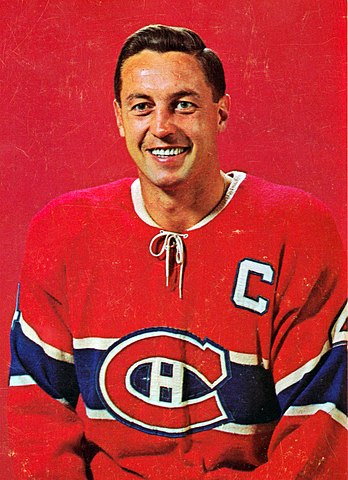
1970s
After winning their 16th Stanley Cup, the Canadiens began the 1969–70 season with high hopes. However, the team fought injuries that kept team stars Jean Béliveau, Henri Richard, Jean-Claude Tremblay, John Ferguson, and Serge Savard off the ice. Additionally, Jacques Laperrière and John Ferguson were suspended, and Gilles Tremblay retired due to illness. Consequently, the team's standings suffered, and the Canadiens watched the 1970 playoffs from the sidelines. Their next season would be Béliveau and Ferguson's last but would also mark the first Canadiens' season for Guy Lapointe. Midway through the season, Al MacNeil took the helm as the team's new coach; he, along with starting goalie Ken Dryden, led the team to their 17th Stanley Cup, Béliveau's 10th as a Hab. Soon after the victory, MacNeil was replaced by Scotty Bowman as coach.
Bowman became a legendary Canadiens coach, leading a team based on speed, scoring, and defence. Although the team lost in 1972 (Guy Lafleur’s first playoffs), they won their 18th Stanley Cup in 1973, and again won four straight Cups from 1974–75 to 1978–79. Amidst their Cup successes, Guy Lafleur emerged as one of the NHL's best players and won multiple awards, including the Conn Smythe, Art Ross and Hart Trophies. The 1979 Stanley Cup final was bittersweet for the team; their 22nd in total, it also marked the last game for Yvan Cournoyer, Ken Dryden, Jacques Lemaire, and coach Scotty Bowman.

1980s
The Canadiens remained competitive during the 1980s, but as the NHL expanded, their domination came to an end. Though they were at the top of league scoring thanks to stars like Guy Lafleur, Pierre Larouche, Steve Shutt, and Pierre Mondou, and the return of coach Claude Ruel, the loss of past stars dropped Montreal to third place by the end of the 1979–80 season. They finished the season without a Cup, the first time in five years. Team general manager Irving Grundman attempted to mix the team up, and drafted Doug Wickenheiser, first overall draft pick, for the next season. Despite a successful season in 1980–81, the Canadiens were swept from the first round of the playoffs by the Edmonton Oilers. Bob Berry replaced Ruel as coach for the 1981–82 season and led the team to their eighth straight year as division champions. However, the division's fourth place team, the Quebec Nordiques, dashed the Canadiens' hopes for a Cup in the first round.
Their eight-year reign as division champions came to an end in the 1982–83 season, when the team finished second in their division and failed to make it past the first round of playoffs for the third year in a row. Subsequently, general manager Irving Grundman was fired, replaced by Serge Savard. The team fell to fourth place in the division during 1983–84, and coach Berry was replaced by former player Jacques Lemaire at the end of February. It was Montreal's first losing season in 33 years. However, the Canadiens defeated both the Boston Bruins and the Quebec Nordiques before they fell to the New York Islanders in the conference final.
During the summer of 1984, Savard picked Patrick Roy in the draft; Roy would, however, play only one period during the 1984–85 season. It was truly the end of an era, as Guy Lafleur announced his retirement on 26 November 1984. The team recorded a mediocre 1985–86 season and finished second in their division. Before the playoffs began, coach Jean Perron sequestered the team in a hotel in Montreal in a bid to focus the team’s energies. The gamble paid off and the Canadiens won their 23rd Stanley Cup in 1986, led by the outstanding goaltending of rookie Roy. They defeated the Calgary Flames four games to one, and the 20-year-old Roy won the Conn Smythe Trophy for playoff MVP, the youngest player to win it to that point. The Canadiens did not finish past the second round of the playoffs until the 1988–89 Stanley Cup finals, when the Canadiens, with Pat Burns behind the bench, met the Calgary Flames again. This time, the Flames were victorious, the first visiting team to win the Stanley Cup on Montreal Forum ice.

1990s
The Montreal Canadiens began the 1990s as one of the top teams in the NHL. This did not, however, stop coach Pat Burns from leaving the team to coach the rival Toronto Maple Leafs at the end of the 1992 playoffs. Jacques Demers took the reins as coach for the 1992–93 season, and his timing could not have been better. The club, unexpectedly, won its 24th Stanley Cup, defeating Wayne Gretzky`s Los Angeles Kings four games to one in the finals. That year's playoff run was remarkable for the 10 straight overtime wins the Canadiens earned. They were, again, led by the spectacular goaltending of Patrick Roy, who won the Conn Smyth Trophy for the second time in his career.
The Cup was the team's last at the Montreal Forum. Although they made it to the playoffs the next year, they were quickly knocked out by the Boston Bruins. The 1994–95 season was cut short by a lockout, and the Canadians missed the playoffs for the first time in 25 years. The team failed to improve by the 1995–96 season, and team management received another overhaul with Réjean Houle as the team's general manager and Mario Tremblay as the new head coach. Just a few months into the season, Roy was traded to the Colorado Avalanche.
The team's last game in the Montreal Forum, where they had played since 1924, was on 11 March 1996. Their next home game, five days later, was played in the Molson Centre (now known as the Bell Centre), the largest arena in the NHL at 21,287 seats. Their first home game was a success, with the Canadiens beating the New York Rangers 4–2. Their next two playoff runs were short lived, with the team losing in the first round in both 1996 and 1997.
In December 1997, the team played its 5,000th game in the NHL. By the end of the season, however, the Canadiens had slipped to seventh in the Eastern Conference and did not advance past the second round of the playoffs. It was just the beginning of their troubles. By December of the 1998–99 season, the team marked an 11-game winless streak and finished the season out of playoff contention, with the lowest point total the team had seen in 40 years.
2000–10
The team’s troubles continued into the 1999–2000 season. The team was plagued with injuries and finished the season out of playoff contention. Then in May 2000, Maurice Richard died; more than 100,000 people attended a public memorial held at the Molson Centre.
In 2001–02, the team made it to the playoffs for the first time in four years. They blasted past the Boston Bruins in the first round but lost to the Carolina Hurricanes in the second round. In 2002–03, the Canadiens missed the playoffs for the fourth time in five years. In the hopes of reviving the struggling team, former Canadien Bob Gainey was hired as the team's new general manager, beginning what has been called the Gainey era.
The era began with a slow start, even with the highlight on 22 November 2003 of the first outdoor NHL game, against the Edmonton Oilers. By the end of the regular season, the team was back in playoff contention but lost in the second round to eventual Cup winners the Tampa Bay Lightning. The team met the same fate in the 2006 playoffs against the Carolina Hurricanes (the 2004–05 season was cancelled due to a lockout).
For the team’s centennial season, 2008–09, the NHL paid tribute to the club’s illustrious history. Montreal hosted the 2009 All-Star Game and, in the off-season, the 2009 NHL entry draft. While the team was the toast of the league, the Canadiens season could only be classified as moderately successful. After finishing eighth in the Eastern Conference with a record of 41–30–11, Montreal was swept in the first round of the playoffs by the Boston Bruins.
The following season (2009–10), Montreal Canadiens fans hoped that hockey glory would return to their team. Jacques Martin took over behind the bench as coach, and a number of players were traded in the hopes of building up the team's star player roster. The Canadiens made franchise history on 28 December 2009, when forward Mike Cammalleri scored Montreal’s 20,000th goal in a game against the Ottawa Senators. After squeaking into the post-season, once again, as the eighth seed, the team surprised everyone by forcing the first round series to a seventh game and defeating the Washington Capitals. They would go on to meet Sidney Crosby and his defending Stanley Cup champions, the Pittsburgh Penguins, in the second round. Again, the team forced and won a seventh game and confirmed their presence at their first Conference Finals since 1993. Their playoff run ended there, however, as the Philadelphia Flyers eliminated the Canadiens in five games. Despite goaltender Jaroslav Halak’s brilliant play in the post-season, the Canadiens traded him to the St. Louis Blues in June 2010, making Carey Price their franchise goalie.
2011–19
There were few highlights for fans in the 2010–11 season. On 20 February 2011, the Canadiens participated in the NHL’s second-ever Heritage Classic, losing 4–0 to the Calgary Flames in an outdoor game played in front of 41,000 spectators at McMahon Stadium in Calgary. In a frightening incident later that season, Canadiens forward Max Pacioretty suffered a severe concussion and fractured vertebra after a hit from Bruins defenceman Zdeno Chara that sent him colliding into a stanchion. Pacioretty missed the remainder of the season, but returned to form the following year, scoring 33 goals and 32 assists in the 2011–12 season. Pacioretty’s recovery from injury was one of the few bright spots for the team, who fired both their general manager and head coach and finished last in their division and conference, missing the playoffs for the first time since 2006–07.
Following an unsuccessful campaign in 2011–12, the club filled its vacant general manager and head coaching positions by hiring Marc Bergevin and Michel Therrien, respectively. In the 2012-13 lockout–shortened season, P.K. Subban won the James Norris Memorial Trophy, which is presented annually to the league’s best defenceman.
The NHL returned to full regular-season play for 2013–14. The Canadiens finished with a record of 46–28–8 and advanced as far as the Eastern Conference finals before faltering to the New York Rangers in a hard fought sixth game.

The following year, due in large part to the strong performance of goaltender Carey Price, the Canadiens won the Atlantic Division and finished the regular season with 110 points, the most since 1988–89. While the team lost in the second round of the playoffs to the Tampa Bay Lightning, Price’s efforts were recognized with the Vezina, Hart, and Ted Lindsay trophies.
In advance of the 2015–16 season, Max Pacioretty was named the 29th team captain in franchise history. Early in the campaign, however, disaster struck. In a game against the Edmonton Oilers on 29 October 2015, goaltender Carey Price suffered a knee injury. He returned to the crease on 20 November but aggravated his injury a few nights later while playing against the New York Rangers. Price ultimately missed the rest of the regular season, which had a significant effect on the team’s performance. The Canadiens finished 13th in the Eastern Conference and missed the playoffs.
In the offseason, on 29 July 2016, the Canadiens stunned the hockey world when they traded their dynamic rearguard P.K. Subban to the Nashville Predators for blue-line stalwart Shea Weber. The trade was controversial because Subban had won the Norris Trophy in 2013 as the league’s top defenceman. He was also beloved by much of the fanbase for his charismatic personality and generosity in the community — particularly his work with the Montreal Children’s Hospital, to which he pledged $10 million in 2015.
In 2016–17, guided by a rejuvenated Carey Price and a 35-goal campaign by captain Max Pacioretty, the Canadiens rebounded from their previous season’s performance and finished atop the Atlantic Division with an impressive record of 47–26–9. Despite their regular season success, the Canadiens fell to the New York Rangers in six games in the first round of the post-season.
Following the conclusion of the 2016–17 season, the Canadiens traded Mikhail Sergachev, their top blue-line prospect, to the Tampa Bay Lightning in exchange for centre Jonathan Drouin, who they promptly signed to a six-year contract. While management believed Drouin’s scoring touch would help the team up front, the Canadiens not only struggled to score in the 2017–18 season but also failed to keep pucks out of their own net. Montreal finished the season with the third fewest goals for and the fifth most goals against in the league.
In the offseason, the Canadiens made several changes, sending Alex Galchenyuk to the Arizona Coyotes for Max Domi and selecting Jesperi Kotkaniemi third overall in the NHL Entry Draft. In September 2018, they traded captain Max Pacioretty to the Vegas Golden Knights in exchange for Tomáš Tatar and prospect Nick Suzuki, as well as a second-round pick in 2019. However, the 2018–19 season was equally disappointing as the team again failed to reach the playoffs.
At the 2019 NHL Entry Draft in June, the Canadiens used their first-round pick to select 18-year-old American right-winger Cole Caulfield. The speedy, diminutive sniper scored 72 goals and 100 points in 64 games with the US under-18 team in 2018–19. He was ranked No. 8 by the NHL’s Central Scouting Bureau ahead of the draft but was still available to the Canadiens, who held the 15th pick, due to concerns over his size (5-foot-7, 163 lb).
2019–20 Season
At the beginning of COVID-19 pandemic in March 2020, the Canadiens were in 12th place in the Eastern Conference with 31 wins, 31 losses and 9 overtime losses. The Canadiens competed in the modified post-season tournament that took place beginning in August 2020. They defeated the Pittsburgh Penguins three games to one in the best-of-five qualifying series. This unexpected success brought the Canadiens into the playoffs for the first time since 2017. The Canadiens took on the much higher-ranked Philadelphia Flyers in the best-of-seven first round, losing in six games.
2021 Season and Stanley Cup Run
The momentum of this unanticipated playoff run carried over into the 2020–21 season, the start of which was delayed until January 2021. Due to the pandemic closing the border between Canada and the US, the Canadiens only played against the six other Canadian teams of the NHL’s temporary North Division for the duration of the regular season and the first two rounds of the playoffs.
On 24 February 2021, Claude Julien, the Canadiens’ head coach since 2017, was fired, along with associate coach Kirk Muller. Coaching duties were transferred to assistant coach Dominique Ducharme. Though the Habs struggled at times through the shortened 56-game season, they nonetheless managed to finish with a record of 24 wins, 21 losses and 11 overtime losses — good for the last of four playoff spots in the North Division.
The Canadiens faced their archrivals the Toronto Maple Leafs in the first round — the first time the two teams had faced each other in the playoffs since 1979. The Habs won the first game 2–1 but lost the next three, putting them one game away from elimination. But Montreal won the next two games in overtime (4–3 and 3–2) before winning Game 7 by a score of 3–1 to shock the Leafs and their fans. In the second round, the Canadiens swept the Winnipeg Jets in four games.
By the third round, the Stanley Cup semifinals, the Canadiens had emerged to become “Canada’s Team” in the quest for the Stanley Cup. They defeated the Vegas Golden Knights four games to two, advancing to the Stanley Cup Finals for the first time since 1993. This also made it the first Canadian team to advance to the finals since the Vancouver Canucks in 2011.
Facing the previous year’s Stanley Cup winner, the Tampa Bay Lightning, the Canadiens lost the first three games of the series before winning the fourth to avoid a series sweep. Ultimately overmatched by the defending champions, the Canadiens lost to the Lightning 1–0 in the fifth game.
In some respects, the 2021 playoff run represented one last gasp for the Canadiens, whose aging core included Carey Price (33), Shea Weber (35), Corey Perry (35) and Eric Staal (36). But at the same time, a new emerging core of Nick Suzuki (21), Tyler Toffoli (28) and Cole Caufield (20) — the team’s top three playoff points leaders in 2021 — along with Brendan Gallagher (28), Jonathan Drouin (25) and Jesperi Kotkaniemi (20) offered promise for the 2021–22 season, especially after goalie Carey Price remained with the team despite being exposed to the Seattle Kraken’s expansion draft on 21 July 2021.
2021 Draft Pick Controversy
During the NHL Entry Draft on 23 July 2021, Canadiens’ General Manager Marc Bergevin announced that the Canadiens were “proud” to select Logan Mailloux as their first-round pick (31st overall). Mailloux had in fact pulled himself out of the draft after he was convicted and fined by a Swedish court on a count of sexual misconduct for sharing an intimate photograph of himself and a young woman without her consent. This was public knowledge, as was Mailloux’s request to go undrafted, but the Canadiens selected him nonetheless. The fierce backlash to this decision prompted Canadiens owner Geoff Molson to issue a public apology. Mailloux was not invited to training camp, but Molson kept the door open to him eventually joining the club if he could demonstrate “maturity.” The “Canadiens’ draft-day debacle,” as the National Post called it, generated an avalanche of bad press only a month after the end of the team’s most successful season in nearly 30 years.
Franchise Ownership
The franchise changed ownership twice in the 2000s. The Montreal Canadiens were owned by Molson Breweries from 1978 to 2001, when they sold an 80.1 per cent interest in the team to American businessman George Gillett. The sale was noteworthy because no Canadian buyer came forward to buy the team at a time when the Canadian dollar was low and Canadian teams were struggling financially. Gillett did well by the team and arena, which he bought for $275 million. In 2009, he sold both to the Molson brothers for $500 million, marking the third time that the team was fully owned by the Molson family. (See also John Molson; John Molson Jr.; Molson Coors Brewing Company.)
Stanley Cup Finals Results
See Montreal Canadiens Stanley Cup Finals Appearances.
Montreal Canadiens in the Hockey Hall of Fame
See Montreal Canadiens in the Hockey Hall of Fame.
See also National Hockey League Timeline.

 Share on Facebook
Share on Facebook Share on X
Share on X Share by Email
Share by Email Share on Google Classroom
Share on Google Classroom

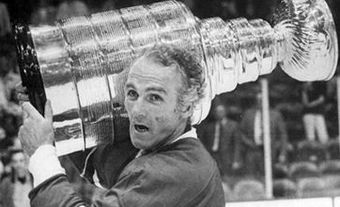
.jpg)

